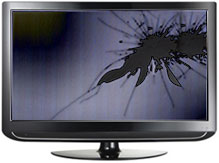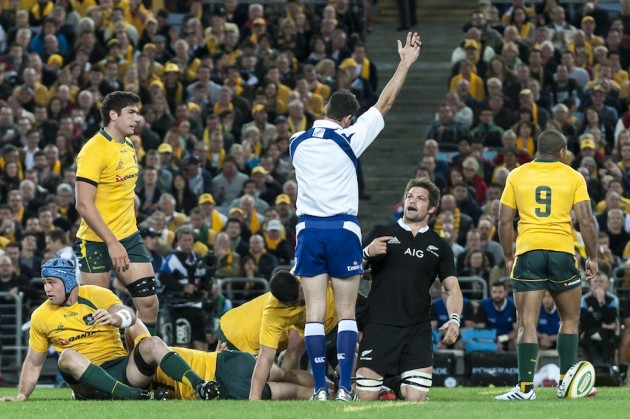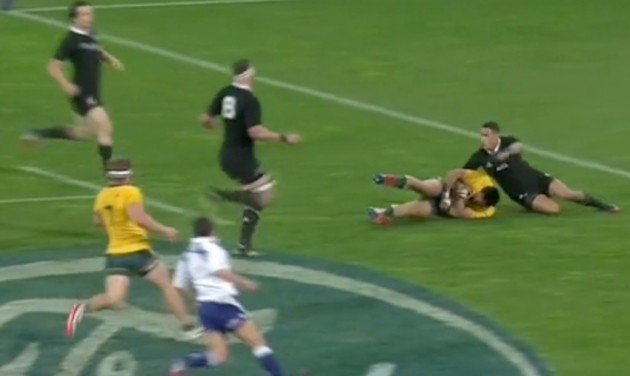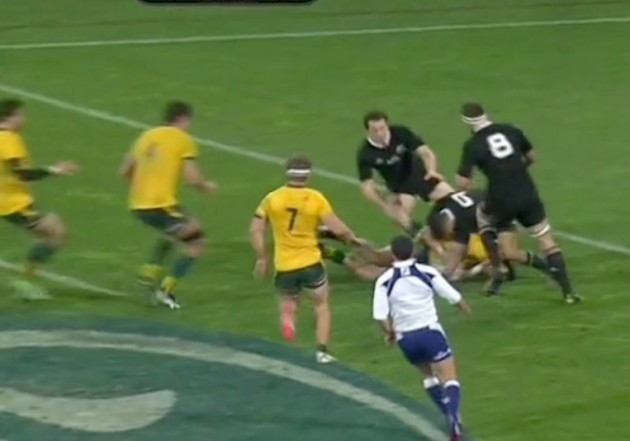 According to official figures yet to be released, over 900 Australian television screens were broken and in excess of 35,000 Australian children shouted at before bed last Saturday night, due Jaco Peyper’s refusal to yellow card an All Black during the second Bledisloe Cup match in Wellington.
According to official figures yet to be released, over 900 Australian television screens were broken and in excess of 35,000 Australian children shouted at before bed last Saturday night, due Jaco Peyper’s refusal to yellow card an All Black during the second Bledisloe Cup match in Wellington.
Even the most sensible and level headed of Kiwi commentators – Justin Marshall (ahem) – was of the opinion that his own countrymen had committed a number of cynical fouls in the ‘rid zone’.
Since then the stink has continued, with Ewen McKenzie publicly shaking his head in disbelief. Just when you thought this was heading in the right direction, G&GR understands (via a leaked email doing the rounds) that spurred by a complaint from by the All Black management, ref Jaco Peyper was allegedly asked to explain in his performance review why he hadn’t yellow carded an Australian player due their repeated infringements!
So readers, as an admittedly one-eyed Wallabies supporter, I decided to attempt to take the eye patch off for a few minutes and get to the bottom of whether my rage had any basis in fact by answering a few simple questions.
1. What should you get yellow carded for “in the red zone”?
According to the IRB laws (which you can see here) there are two ways you can get carded for repeat infringement:
- A single player repeatedly infringes ‘10.3a – …a player penalised for repeated infringements must be cautioned and temporarily suspended’
or
- A team repeatedly infringes ‘10.3b…When different players of the same team repeatedly commit the same offence, the referee must decide whether or not this amounts to repeated infringement. If it does, the referee gives a general warning to the team and if they then repeat the offence, the referee cautions and temporarily suspends the guilty player(s)’
In neither of these laws is the position on the field even mentioned. According to the IRB laws there is no “red zone” for repeated infringements.
It’s only when you look at game management guidelines, like the ones the ARU publishes, that you see statements like this;
Repeated and Deliberate Infringements
- A referee must warn a team through the captain about repeated infringements prior to taking yellow card action.
- Repeated team infringements can be: deliberate infringements can result in a Penalty Kick and a caution (yellow card) without any warning, depending on the cynical nature of the infringement.
- A number of different offences in a short period of time,
- A pattern of similar offences without a time limit (eg. regular offences close to the defending team’s goal line), or
- Repeated infringements by an individual without a time limit.
- Deliberate infringements can result in a Penalty Kick and a caution (yellow card) without any warning, depending on the cynical nature of the infringement.
- If a Penalty Try is awarded and the offender can be identified, then either a caution (yellow card) or send off (red card) must follow.
So the red zone is not a formal or definitive idea, just something that refs use when applying context. By that I mean a team yielding a bunch of penalties in the opposition’s end of the field is much less likely to be cautioned than if they’re doing it near their goal line. The IRB laws don’t state that, but it’s how refs apply it.
2. According to Peyper’s penalties, should there have been a yellow for repeated infringements in the red zones?
To get my head around this I went back through the tape and put a video together of all the penalties awarded by Jaco Peyper by the defensive team in their 22. I’ve also included where he stated advantage, although we’ve all seen players escape cardings when when the advantage lapses, so these clearly do not carry the same weight.
I haven’t otherwise interpreted or said where he should or shouldn’t have either penalised or stated advantage. For example I haven’t included Keiran Read’s alleged offence after Aaron Smith’s (Read’s, I think, is dubious anyway).
Here they are.
[one_half last=”no”]
All Black penalties in their 22
5.44 – Offside at ruck by black No. 3
20.52 – Deliberate knock down by black No. 14
23.41 – Not releasing by black No. 9
45.38 – Off feet by black No. 10
55.54 – Not releasing by black No. 7 (ADV)
56.00 – Offside by black No. 13[/one_half]
[one_half last=”yes”]
Wallabies penalties in their 22
9.58 – Not on feet by gold No. 10
35.23 – Not releasing by gold No. 8
39.00 – Offside by gold No. 12 (ADV, try scored)
73.00 – Off feet by gold No. 20 (ADV)
74.818 – Offside by gold No. 7[/one_half]
In the end Peyper penalised the All Blacks five times in their 22, and penalised the Wallabies three.
One of the first things you’ll notice is that no one player is penalised twice on either side. This would usually be the fastest way to a yellow.
Second, you’ll notice that there isn’t a clear pattern in either string of penalties, in terms of the same penalty type.
Third, in terms of time, no team really builds up more than two penalties on the trot. The Wallabies do this once, the All Blacks twice.
Looking at this dispassionately I would say that the All Blacks should have been warned on that final penalty at 56 minutes – especially considering there were two infringements within the one penalty. That Jaco didn’t warn them turned out to be immaterial anyway, as there was no ‘red zone’ penalty after it.
There is no case for the Wallabies to answer.
3. Was Aaron Smith’s penalty a yellow card?
Back to the IRB law, under Unfair Play it says:
10.2a Intentionally Offending. A player must not intentionally infringe any Law of the Game, or play unfairly. The player who intentionally offends must be either admonished, or cautioned that a send off will result if the offence or a similar offence is committed, or sent off. Sanction: Penalty Kick
A penalty try must be awarded if the offence prevents a try that would probably otherwise have been scored. A player who prevents a try being scored through foul play must either be cautioned and temporarily suspended or sent off.
However, ARU game management guidance says
Deliberate infringements can result in a Penalty Kick and a caution (yellow card) without any warning, depending on the cynical nature of the infringement.
Was it deliberate? Look at this frame, taken as Smith and Christian Leali’ifano are sliding along the ground in the tackle.
In this frame and a number that follow it, Smith is clearly looking up to assess the situation – how much support does he have, how much does Leali’ifano have. Quite impressive really. There can be no doubt that Smith’s action was deliberate and therefore cynical.
The next test is whether or not ‘the offence prevents a try that would probably otherwise have been scored’. Looking at the frame below, which is just when Smith has gotten to his feet (but without releasing), you can see that there are three Wallaby players in support against two All Blacks, who at this time have not come through the gate at the tackle and therefore have no right to play the ball.
In theory, if Leali’ifano had been able to play the ball, he had three men to pop a pass to. However, any Wallaby supporter will tell you that this is no slam dunk try, especially with defenders in the mix. It wasn’t as if a player just had to fall on a ball or run unopposed over the line.
Upshot
Neither side had a case to answer for losing a player through repeated infringements based in the “red zone”. Sitting back and looking at those penalties and how they fell in the match, I’d be a lot happier if I were the New Zealand management team, than the Wallabies. In retrospect they “just so happened” to fall at more strategic times in the match. Luck or rat-cunning, you decide.
As for Aaron Smith’s penalty, according to game management guidelines he gets a yellow card. According to IRB laws alone he gets penalised and a warning. This is an area in which there’s still plenty of grey, and of which the All Blacks have once again got the rub of the green.




